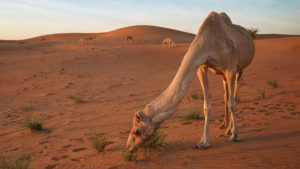ABU DHABI / AD MEDIA OFFICE
To mark World Camel Day, which falls on June 22 each year, Abu Dhabi Agriculture and Food Safety Authority (ADAFSA) is stepping up its efforts to develop camel livestock and reinforce its status as an authentic cultural heritage, alongside strengthening its economic position within the food security system. This is achieved by providing quality veterinary services, raising awareness about the importance of camel health, breeding, and production, and participating in international efforts to
ensure the growth and sustainability of the strategic sector. The camel population in Abu Dhabi emirate is 476,082, with 99,071 in Abu Dhabi (83,879 females and 15,192 males), 254,034 in Al Ain (215,968 females and 38,066 males), and 122,977 in Al Dhafra Region (104,987 females and 17,990 males).
This year’s celebration coincides with the International Year of Camelids, declared by the United Nations for 2024, which aims to highlight the economic and cultural value of camels in more than 90 countries. It also emphasises their important role in enhancing food security by providing milk, meat, and fibre, as well as their use as a means of transporting goods and people in some communities, contributing to achieving sustainable development goals related to eradicating hunger, eliminating poverty, empowering women, and protecting and sustaining ecosystems. ADAFSA provides comprehensive care for camels, including preventive, curative, and productive veterinary services, providing vaccines and medicines, and combating diseases and pests. In the past year, 185,797 veterinary services were provided to 130,700 camels, covering various types of treatments, examinations, and follow-ups. Additionally, the authority provided camel spraying services to combat external parasites for 237,487 camels during the past year 2023.
Since 2009, ADAFSA has supported the Al Dhafra Camel Mazayna (beauty competitions) Festival by providing curative and preventative veterinary services and conducting laboratory tests for participating camels. The same applies to camel races, where the authority offers veterinary services to participating camels. ADAFSA’s annual involvement ensures the health and safety of camels and promotes fair competition among participants.
The authority also issues veterinary health certificates for camels intended for export to various countries, in addition to routine fertility checks, ear-tagging and logging in the animal identification and registration system, as well as routine spraying to combat external parasites.
As part of raising awareness about the importance of camel care, the authority has produced various brochures containing guidelines on best practices for camel breeding and care. ADAFSA has also published the Atlas of Camel Pathology, recognised by the World Organisation for Animal Health (WOAH), which is full colour encyclopaedia of all diseases requiring surgical intervention for camels prevalent in the UAE and the Arabian Peninsula. The authority also organises numerous educational lectures on the benefits of camel milk and workshops to educate camel breeders about camel diseases, their prevention and treatment methods, and biosecurity requirements that enhance camels’ immunity against diseases.
Internationally, ADAFSA participates in efforts to maintain camel health, including a joint study with the Food and Agriculture Organisation of the United Nations (FAO) on coronaviruses in camels, collecting samples in collaboration with UAE universities. The ADAFSA Collaborating Centre for Camel Diseases, recognised by WOAH, continues its pioneering research, developing techniques for diagnosing epidemic animal diseases, including camel diseases, supporting epidemic response efforts, capacity building, and disseminating scientific knowledge about camel diseases.
Over the past two years, the centre has provided laboratory analysis services for more than 100,000 samples, totalling more than 500,000 analyses for various diseases collected from camels. It has also developed more than 150 advanced laboratory analyses enabling accurate identification of pathogens, supporting strategic plans for the prevention, control of epidemic diseases, and food security.
The centre has also established the first biobank of reference materials for the conservation of biological isolates and specialised tissue culture cells from camels. This biobank will improve disease control, vaccine development, diagnostic kits, laboratory analysis methods, scientific research and training.
In terms of scientific publishing, experts and specialists at the centre have published more than 30 scientific papers on animal and human diseases (from a One Health perspective) in reputable scientific journals. Additionally, several activities have been carried out within the Middle East Camel Network (CAMENET), which includes Gulf Cooperation Council (GCC) countries, as well as Jordan and Yemen. The network aims to contribute to the development, unification, and validation of diagnostic methods for major camel diseases according to internationally approved standards and procedures, enhance scientific and technological capabilities in the field of epidemiology and camel disease diagnosis in the region, and characterise and define camel ecotypes based on their morphological traits.
Furthermore, the network aims to disseminate knowledge about camel disease control and best practices in camel production among member states and the international scientific community, promote studies and research on camel breeding and production practices and their socioeconomic importance, and identify risks and other threats to animals, humans, and the environment. It also facilitates cooperation between national, regional, and international institutions and reference laboratories affiliated with FAO, WOAH and collaborating centres for capacity building, experience exchange, and collaboration.
The Reference Centre has enriched the global gene bank with several complete or partial genetic sequences of various pathogens affecting camels, enhancing the country’s position in camel disease research. Additionally, relying on modern diagnostic tools will significantly aid in the accuracy of diagnosis and unravelling the mysteries of many camel diseases.
Knowing the genetic sequences of camel pathogens, especially viruses, helps in controlling them by understanding their epidemiology, aetiology, and genetic maps. It also aids in developing new diagnostic methods or studying the possibility of combining or mutating viruses, resulting in viruses with varying virulence, thus enhancing the efficiency of diagnosing different camel diseases.
 The Gulf Time Newspaper One of the finest business newspapers in the UAE brought to you by our professional writers and editors.
The Gulf Time Newspaper One of the finest business newspapers in the UAE brought to you by our professional writers and editors.
